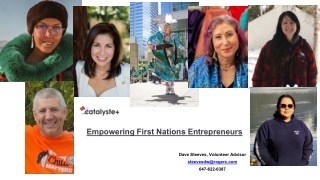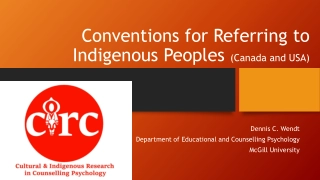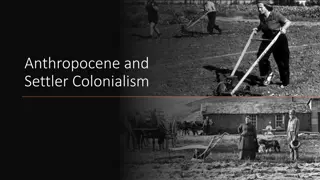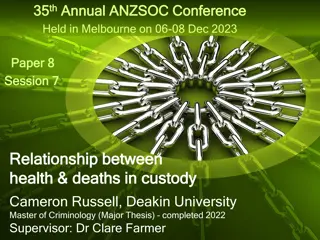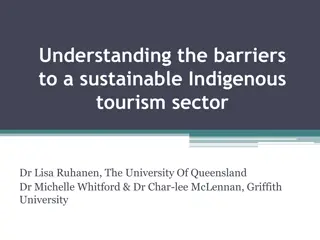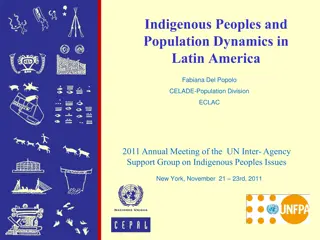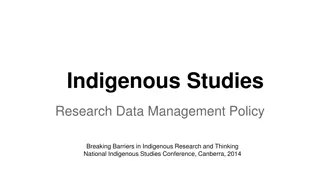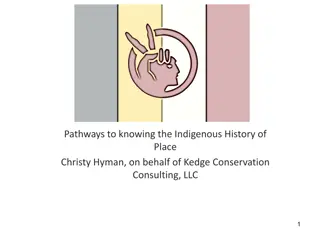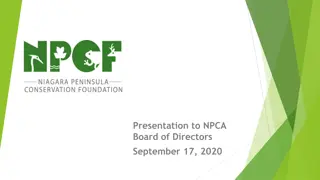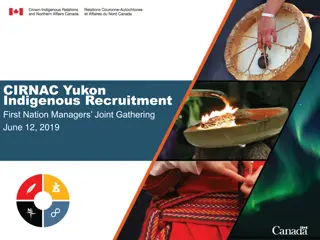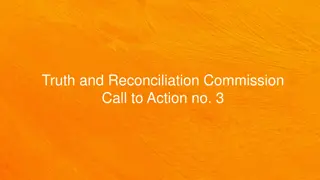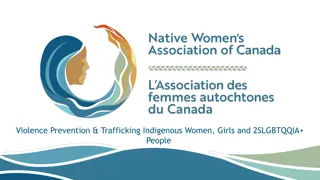Uncovering the Past: Indigenous History of the Delmarva Peninsula
Delve into the rich indigenous history of the Delmarva Peninsula, acknowledging the injustices and hardships faced by Native American communities. From Columbus' invasion to the Trail of Tears, explore the impact of colonization on indigenous peoples and the ongoing efforts to address historical misrepresentations. Learn about the struggles faced by the local Indian populations, the broken treaties, and the forced relocations that have shaped the narrative of Native Americans in this region.
Download Presentation

Please find below an Image/Link to download the presentation.
The content on the website is provided AS IS for your information and personal use only. It may not be sold, licensed, or shared on other websites without obtaining consent from the author. Download presentation by click this link. If you encounter any issues during the download, it is possible that the publisher has removed the file from their server.
E N D
Presentation Transcript
Past History of the Delmarva Peninsula Indigenous People s Day, October 12, 2020
A long time ago when the population in North America, was around 50 million or more Columbus invaded Turtle Island (N. & S. America) in 1492, and between that time, and about 1900, Historian Ned Blackhawk estimated that indigenous people were enslaved. between 2.5 and 5 million This beginning predated African servitude, particularly in the American South (Teaching Tolerance.org) We need to acknowledge the truth in order to move forward. Currently, there is an absence of, or misrepresentation of Indigenous people and culture.
Past History This country was built on Native lands, and on the backs of slave labor and the country still has not come to grips with that. The Native communities are still dealing with the effects The Native story is dealt with in 8 or 9 snapshots- Sacajawea, Pocahontas (b. 1596, Amonute), Chief Seattle, Thanksgiving story President Andrew Jackson signed the Indian Removal Act of 1830, leading to the evacuation of most Native Americans from their ancient homelands: Acquisition of Native American land east of the Mississippi River. The Trail of Tears was a series of forced relocations of approximately 60,000 Native Americans between 1830 and 1850 by the United States government. Kill the Indian in him, and save the man. Capt. Richard J. Pratt, 1892 Treaties with the Indigenous Peoples have been broken, and broken again Mismanagement of the Bureau of Indian affairs has happened
Locally, in this area where people spoke Lanape, a dialect of Algonquin: The local Indian population was moved north then west in gradual steps (Indiana, for example was land promised to the Indians thus the name) pushing Indians in the areas now known as western PA, Ohio, Indiana, etc. further west until they were rounded up and taken to Oklahoma where many of the Lenape were forced to join the Cherokee on their apportioned lands, and they were then no longer called by their original tribal names but were called Cherokee. At that point, their original language mostly disappeared into a conglomeration of Cherokee and English.
The more southern of the coastal Indians here on the Shore, for the most part, got sold down the river (down the Chesapeake and to the southern cotton plantations where they basically chose to starve themselves to death.) Some got caught up in the more famous Trail of Tears where they were forced to walk to Oklahoma with the Eastern Cherokee. Again, many chose starvation and death
The Pocomoke area people were part of a larger group most directly aligned with the Nanticokes. Maryland gave them an area of land similar to a reservation. In 1742, the Nanticoke were tired of nearly 100 years of conflict. Their leaders met in Winnasoccum Swamp, near the Pocomoke River to plan for war. The plan, however, came to an end when a Choptank Indian informed Maryland colonists and leaders. They threatened to take the Nanticoke land. As the Powhatan Tribes (across the Bay in VA) had all faced similar conflicts, some of the Nanticoke, tired and disgusted, chose to accept an offer from the Six Nations of the Iroquois in the New York, Pennsylvania, and Canadian areas.
Beesoon Meekwins (my friend) ancestors, for example, ended up in Ontario. Once their enemies, the Iroquois promised the Nanticoke both land and protection. The offer was also extended to other tribes, including the Cayuga, Seneca, Oneida, Onondaga, Mohawk, and Tuscarora. Other tidewater tribes in the Delaware - Maryland area chose to move west to the Oklahoma Territories. In fact, all of the Nanticoke did not leave the Eastern Shore. Starting in 1744, some individual families left in dug-out canoes and traveled north up the Susquehanna River. (There is a town called Nanticoke on the Susquehanna river just south of Wilkes-Barre, PA.)
Others walked westward. But, a significant number of Nanticoke moved eastward into Delaware and settled in Indian River Hundred, near the Indian River. By the 1800's, the Nanticoke who remained had purchased land and assimilated into the predominant culture. At the end of the 17th Century, the Nanticoke and the Choptank were the only native tribes still living on the Eastern Shore of what is now Maryland, thereby surviving 70 years of conflict and contact with European settlers. As the numbers of settlers increased, the Nanticoke's traditional hunting and farming was disrupted.
Records show that colonists complained that the Nanticoke and other tribes tried to add to their diet by stealing a few hogs and cattle from the settlers. However, the increase of colonists and the decrease in forests had severely depleted game. Although colonial authorities tried at first to protect the Indians traditional existence, both the settlers and traders ignored the local government's suggestions for co-existence with the native people. Unfairly treated, and their way of life severely restricted, Nanticoke and other Indians tried to protect themselves through raids and threats of war. Unfortunately, in 1642 and again in 1647, Maryland Governor Thomas Greene ordered Capt. John Pike of the militia, to attack and destroy the Nanticoke village and gardens to force them out of the area.
Why didn't the Nanticoke negotiate a peace treaty for protection? Actually, the first of five treaties were signed in 1668 by Chief Unnacokasimmon to establish peace between Maryland and the Nanticoke. Yet, the treaties were unfair to the Nanticoke. Settlers continued to illegally seize the lands of the Nanticoke and other tidewater tribes. Eventually, the Nanticoke and the Choptank asked Maryland authorities to grant them specific tracts of land. In the early 18th Century, the Maryland Assembly set aside land for three reservations. Three thousand acres were set aside for the Nanticoke on Broad Creek along the river and creek areas. This helped at first, but it disrupted the seasonal hunting of the Nanticoke who needed to travel between their traditional winter hunting grounds and their spring and summer farming & fishing sites. Remaining year round on the reservation severely restricted food and shelter. Traditionally, Indians moved away from the shores and went inland before the cold of winter came.
Furthermore, Maryland authorities included a stipulation that the only way the Nanticoke could legally retain reservation lands was if they agreed not to leave. Again, the Nanticoke leaders petitioned the authorities for temporary permission to leave during winter months to hunt. Finally, Maryland authorities agreed, but when the Nanticoke returned the following spring, they found homesteads on their land by squatters who assumed ownership by "right of occupancy." Trespassers also destroyed reservation land by harvesting large amounts of timber. While visiting the reservations, traders brought liquor to exchange for furs. The Indians, who had never had alcoholic beverages, often awoke to find they had traded valuable furs for more liquor, instead of tools, clothing, and goods. (Nanticoke History) google
Grade school children were taken from their homes on this shore and sent to a church run boarding school by the U.S. Government. Carlisle Carlisle Indian Industrial School schools. School, in Pennsylvania was one of those The children were fed poor quality food, and were threatened for speaking their native language. Just like other English Language learners, it took time to learn English, and they did not understand what was being said to them in English. Many of the children died. Those that survived came home without knowing their own personal history or language. (Wub-e-ke-niew, 1995) Wub sneighbor s granddaughter, Susan Prentice Hallett (Bagwajikwe), who is a Ojibwe quilt- maker, is now learning and using her native language: Anishinaabe so there is some hope. Wub lived in Red Lake, Minnesota and was forced to go to Carlisle, when he was small.
"All people are inherently responsible for their actions. Everyone is put here for a purpose. When people take the responsibility that is theirs, and eliminate the many facets of violence which are entrenched in their culture, then we can all address the health of human society and Grandmother Earth in an effective holistic way, and restore harmony and balance" -Wub-e-ke-niew 1995 (quote from We Have The Right To Exist: A Translation of Aboriginal Indigenous Thought The first book ever published from an Ahnisinahbaeojibway Perspective, 2nd edition.)
We are on the land of the Nanticoke. . https://www.popularmechanics.com/culture/web/a23652890/tribal-map-indigenous-peoples-day-2018/
It would be nice In would be nice to add We are on the land of the Nanticoke to put on our paperwork to recognize who was here before and who are here still. I am grateful for the opportunity to live here. The price was enormous for the original inhabitants.




